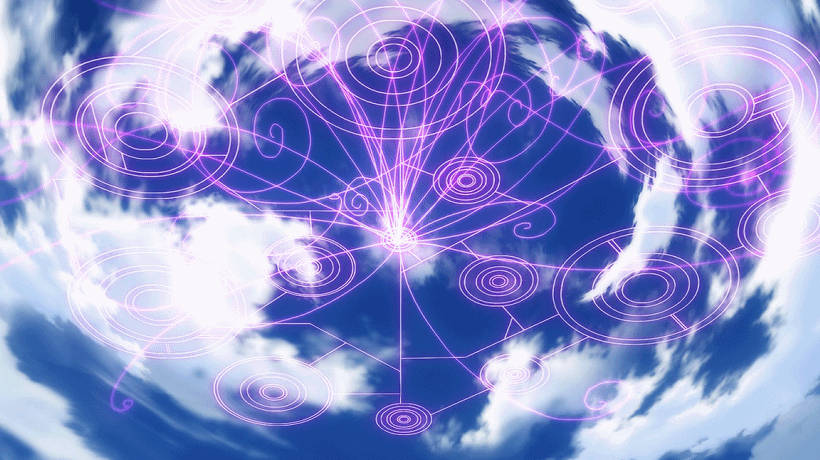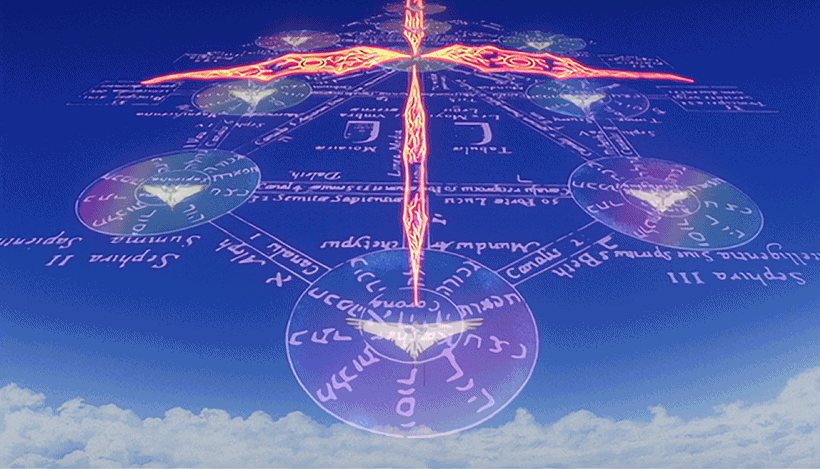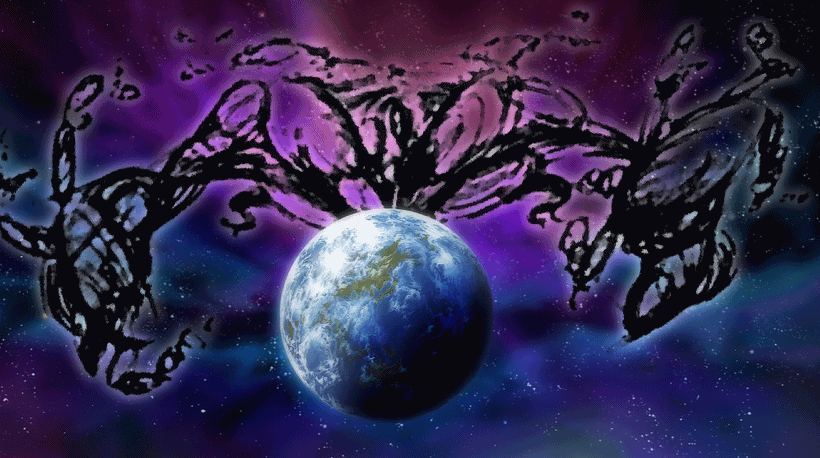I’ve recently finished watching a rather popular anime series called “Madoka Magica”, with an eye in particular to its symbolism. It basically is for the magical girls genre what Evangelion was for the big robots anime. A deconstruction of the medium spiced up with a spark of modern realism.
The ending of Madoka Magica is an ending self-aware of the existence of Evangelion. Actually the whole series is, and it can be seen as a: “what if Shinji was a magical girl?.” In many ways Madoka Magica is an answer to Evangelion. It is far less dense and pretentious. There are no sidetracks and this makes it quite straightforward and maybe simplistic. It can be quite heavy on symbolism, but whereas Evangelion draws its lifeblood from its metaphysical and metaphorical depth, in Madoka this level is subservient to the story and merely adding a rather shallow psychological layer. The symbols exist in a one to one relationship without some higher or elusive spiritual meaning. But that also means everything is self-contained and it isn’t more than what it appears to be. So, taken as a whole, the story is more coherent even if it ends again in the purely metaphysical.
You can notice this pattern I described in the use of symbolism. Where Evangelion didn’t shy away from overt Kabbalistic symbolism, Madoka Magica basically reproduces the exact same scenes, but without openly referencing them. So for example you still get the Tree of Life, but it looks different:

Compared to Evangelion’s own version, that doesn’t dissimulates its origin:

And you get Evangelion Sephirotic wings around the earth too, but they also look different (and are consistent with that mythological/psychological look and meaning that goes through the series):

Which is still only a very simplified and blander version of what Evangelion did:

But what made me write this post was this explanation of the ending (just the very first link I came across) that mentioned a typical time paradox:
If Madoka destroys her own witch , doesn’t that create a time paradox?
My good friend Catcher answers this marvelously well. “This is best answered in a reference to the ageless question “Which came first, the chicken or the egg?” The idea behind the question is of circular logic: the chicken lays the egg, but the egg houses the developing chicken. Madoka’s disappearance can be explained in a similar fashion. After Madoka gathers all the grief from the mahou shoujo, she literally has nothing else to do rather than to house this grief, which takes the form of a giant soul gem that we see take the form of a world-devouring witch. Her wish, however, mandates her to destroy herself in her witch form (which would be in her own immediate future), thus eliminating her from the plane of existence that Homura is in. She’s essentially created a paradox for herself, thus why she can’t take a material form.
This type of paradox is the standard in time travel sci-fi stories, but I remember I used it to give a scenario on consciousness. What if we reach a point where we truly know everything and so can control everything about conscious experience. The “singularity” so to speak. My idea is that “truth” ceases to exist. It’s truth itself to be made virtual. Meaning that the pattern that is created, is similar to the one described here about the time paradox.
Think for example to the hypothetical scenario where human beings continue to exist “forever”. Eventually they will be able to develop “total knowledge”. Meaning that their knowledge becomes equal to the totality of the system. Meaning, as explained in the previous posts, being equal to god (also known as the “Omega point”). So what if “god” isn’t the entity that was before the beginning and that created the world, but was instead an entity in the FUTURE, that got control and gave origin to a new cycle? The time paradox is repeated here: we need a “timeline” that leads humanity up to acquire total knowledge, but at that point total knowledge means that “reality” and “time” become relative and virtual. Meaning that the timeline that lead up to the singularity is cut away and sealed. It ceases to exist. Only a circular, independent virtuality is left.
And this was also my interpretation of Wittgenstein’s Tractatus Logico-Philosophicus. Quoting the actual end:
My propositions are elucidatory in this way: he who understands me finally recognizes them as senseless, when he has climbed out through them, on them, over them. (He must so to speak throw away the ladder, after he has climbed up on it.)
He must surmount these propositions; then he sees the world rightly.
Whereof one cannot speak, thereof one must be silent.
The idea of this ladder that you use to reach some elevated place and the idea that the ladder itself has to vanish after it has been used, is to me the same as the time paradox, where there’s a history that has to lead up to an event, an history that then is cut away and vanishes when a circularity is triggered and made independent from the rest.
While scrolling tat page I also noticed these two quotes:
The subject does not belong to the world but it is a limit of the world.
The philosophical I is not the man, not the human body or the human soul of which psychology treats, but the metaphysical subject, the limit—not a part of the world.
That again seem to relate with my idea of Free Will as an occluded horizon. An imposed limit, as metaphorically described in Kabbalah, opposed to the “truth” of a continuous, undivided world.
Finally, both Madoka Magica and David Foster Wallace’s Infinite Jest are founded on this idea of human emotions as an endless source of energy that can defy entropy, in DFW’s case especially as a self-feeding circularity (and also with obvious sense of humor).


2 Comments
In episode 12 I have a problem understanding one thing. The first time Homera uses her ability to time travel she immediately goes to Modoka in class as says she’s now a magical girl too. Modokas response perplexes me. As she seems fully aware of magical girls and embarrassed in class to have it brought up. It then shows Modoka and Mami overseeing Homera use her powers. So if modoka already was a magical girl and/or knew Mami, then how is it possible for Homera to go back in time to prevent Modoka from becoming a magical girl?
EP10 starts with the first encounter of Homura and Madoka.
There Madoka confesses she is a one-week novice.
The next time Homura starts over in her hospital bed,
her schedule is shown where her discharge date is one week
before her first school attendance (in Japanese).
So apparently Homura went to school earlier than scheduled,
before Madoka made a contract with Q-bey.
The idea of split singularity is displayed in the Rebellion
movie. Thanks for your clarification, now I understand
why Madoka’s real half lost her memory, though I presume
her other half (the concept one) still remembers history.